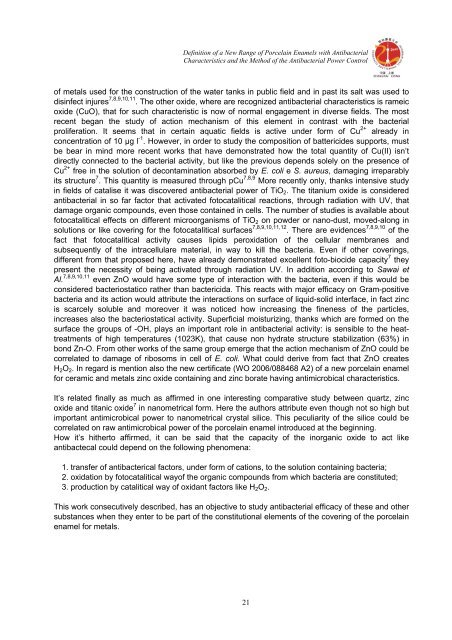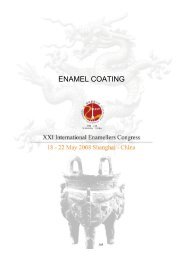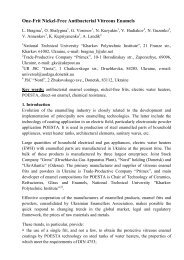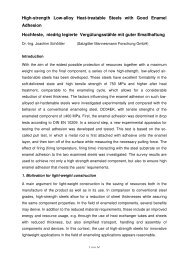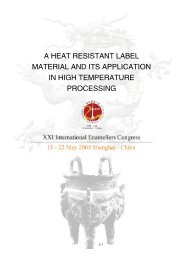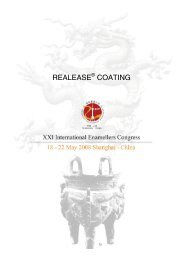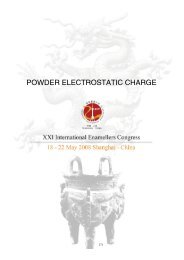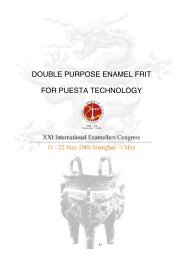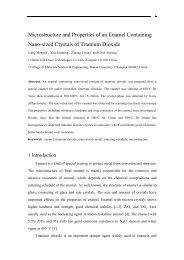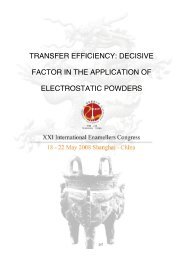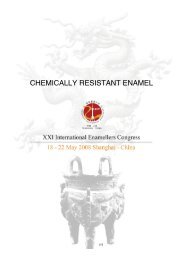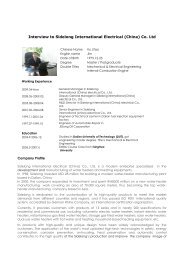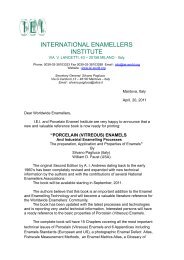definition of a new range of porcelain enamels with antibacterial ...
definition of a new range of porcelain enamels with antibacterial ...
definition of a new range of porcelain enamels with antibacterial ...
- No tags were found...
Create successful ePaper yourself
Turn your PDF publications into a flip-book with our unique Google optimized e-Paper software.
Definition <strong>of</strong> a New Range <strong>of</strong> Porcelain Enamels <strong>with</strong> AntibacterialCharacteristics and the Method <strong>of</strong> the Antibacterial Power Control<strong>of</strong> metals used for the construction <strong>of</strong> the water tanks in public field and in past its salt was used todisinfect injures 7,8,9,10,11 . The other oxide, where are recognized <strong>antibacterial</strong> characteristics is rameicoxide (CuO), that for such characteristic is now <strong>of</strong> normal engagement in diverse fields. The mostrecent began the study <strong>of</strong> action mechanism <strong>of</strong> this element in contrast <strong>with</strong> the bacterialproliferation. It seems that in certain aquatic fields is active under form <strong>of</strong> Cu 2+ already inconcentration <strong>of</strong> 10 μg l -1 . However, in order to study the composition <strong>of</strong> battericides supports, mustbe bear in mind more recent works that have demonstrated how the total quantity <strong>of</strong> Cu(II) isn’tdirectly connected to the bacterial activity, but like the previous depends solely on the presence <strong>of</strong>Cu 2+ free in the solution <strong>of</strong> decontamination absorbed by E. coli e S. aureus, damaging irreparablyits structure 7 . This quantity is measured through pCu 7,8,9 More recently only, thanks intensive studyin fields <strong>of</strong> catalise it was discovered <strong>antibacterial</strong> power <strong>of</strong> TiO 2 . The titanium oxide is considered<strong>antibacterial</strong> in so far factor that activated fotocatalitical reactions, through radiation <strong>with</strong> UV, thatdamage organic compounds, even those contained in cells. The number <strong>of</strong> studies is available aboutfotocatalitical effects on different microorganisms <strong>of</strong> TiO 2 on powder or nano-dust, moved-along insolutions or like covering for the fotocatalitical surfaces 7,8,9,10,11,12 . There are evidences 7,8,9,10 <strong>of</strong> thefact that fotocatalitical activity causes lipids peroxidation <strong>of</strong> the cellular membranes andsubsequently <strong>of</strong> the intracellulare material, in way to kill the bacteria. Even if other coverings,different from that proposed here, have already demonstrated excellent foto-biocide capacity 7 theypresent the necessity <strong>of</strong> being activated through radiation UV. In addition according to Sawai etAl. 7,8,9,10,11 even ZnO would have some type <strong>of</strong> interaction <strong>with</strong> the bacteria, even if this would beconsidered bacteriostatico rather than bactericida. This reacts <strong>with</strong> major efficacy on Gram-positivebacteria and its action would attribute the interactions on surface <strong>of</strong> liquid-solid interface, in fact zincis scarcely soluble and moreover it was noticed how increasing the fineness <strong>of</strong> the particles,increases also the bacteriostatical activity. Superficial moisturizing, thanks which are formed on thesurface the groups <strong>of</strong> -OH, plays an important role in <strong>antibacterial</strong> activity: is sensible to the heattreatments<strong>of</strong> high temperatures (1023K), that cause non hydrate structure stabilization (63%) inbond Zn-O. From other works <strong>of</strong> the same group emerge that the action mechanism <strong>of</strong> ZnO could becorrelated to damage <strong>of</strong> ribosoms in cell <strong>of</strong> E. coli. What could derive from fact that ZnO createsH 2 O 2 . In regard is mention also the <strong>new</strong> certificate (WO 2006/088468 A2) <strong>of</strong> a <strong>new</strong> <strong>porcelain</strong> enamelfor ceramic and metals zinc oxide containing and zinc borate having antimicrobical characteristics.It’s related finally as much as affirmed in one interesting comparative study between quartz, zincoxide and titanic oxide 7 in nanometrical form. Here the authors attribute even though not so high butimportant antimicrobical power to nanometrical crystal silice. This peculiarity <strong>of</strong> the silice could becorrelated on raw antimicrobical power <strong>of</strong> the <strong>porcelain</strong> enamel introduced at the beginning.How it’s hitherto affirmed, it can be said that the capacity <strong>of</strong> the inorganic oxide to act likeantibactecal could depend on the following phenomena:1. transfer <strong>of</strong> antibacterical factors, under form <strong>of</strong> cations, to the solution containing bacteria;2. oxidation by fotocatalitical way<strong>of</strong> the organic compounds from which bacteria are constituted;3. production by catalitical way <strong>of</strong> oxidant factors like H 2 O 2 .This work consecutively described, has an objective to study <strong>antibacterial</strong> efficacy <strong>of</strong> these and othersubstances when they enter to be part <strong>of</strong> the constitutional elements <strong>of</strong> the covering <strong>of</strong> the <strong>porcelain</strong>enamel for metals.21


